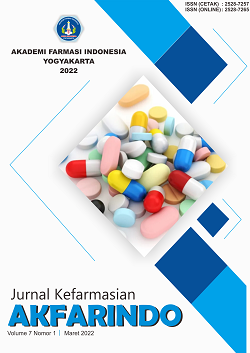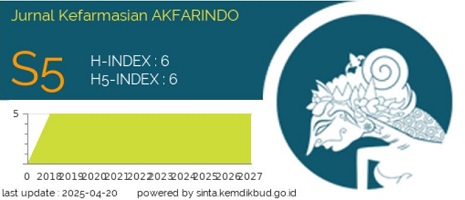FORMULASI DAN KARAKTERISASI MIKROEMULGEL ETIL P-METOKSISINAMAT (EPMS) DARI RIMPANG KENCUR (Kaempferia galanga Linn)
Abstract
Ethyl p-methoxycinnamate (EPMC) is the main compound from the rhizome of kencur (Kaempferia galanga Linn) isolated with a non-polar solvent, n-hexane. Several studies have proven that EPMC has a pharmacological effect as an anti-inflammatory. The purpose of this study was to make a topical formulation of EPMC using microemulgel preparations. The method used in the manufacture of microemulsions is to make a spontaneous microemulsion system and load it into a gel base. The oil phase used is isopropyl myristate, the surfactant used is tween 80, cosurfactant ethanol 96%, gelling agent is carpopol 340, triethanolamine (TEA) as a base and propylene glycol as a humectant. The dose of EPMC used was 200 g/mL. Four microemulgel formulations have been made, namely B1, B2, B3 and B4 with various concentrations of surfactant and cosurfactant. The results showed that the best formula was B3 formula with 5% isopropyl myristate, 40% Tween 80, 10% ethanol 96%, 10% propylene glycol, 1% carbopol, TEA and aquades. The conclusion of this formula is that the use of surfactants and cosurfactants in large quantities makes a transparent appearance and better stability than other formulations.
References
Hayati, F., Mudatsir and Safarianti (2017) ‘Antibacterial Activity Testing Etanol Ekstrak of Galanga Rhizome (Kaempferia galanga L) Against Clinical Isolate ESBL Klebsiella pneumoniae In Vitro’, Jurnal Ilmiah Mahasiswa Medisia, 2(1), pp. 68–73.
Iradhati, A. H. and Jufri, M. (2017) ‘Formulation and physical stability test of griseofulvin microemulsion gel’, International Journal of Applied Pharmaceutics, 9(April), pp. 23–26. doi: 10.22159/ijap.2017.v9s1.22_27.
Jagadish, P. C. et al. (2016) ‘Extraction, characterization and evaluation of Kaempferia galanga L. (Zingiberaceae) rhizome extracts against acute and chronic inflammation in rats’, Journal of Ethnopharmacology. Elsevier, 194, pp. 434–439. doi: 10.1016/j.jep.2016.10.010.
Komala, I. et al. (2018) ‘Structure-activity relationship study on the ethyl p-methoxycinnamate as an anti-inflammatory agent’, Indonesian Journal of Chemistry, 18(1), pp. 60–65. doi: 10.22146/ijc.26162.
Lakshmanan, D. et al. (2011) ‘Fitoterapia Ethyl p -methoxycinnamate isolated from a traditional anti-tuberculosis medicinal herb inhibits drug resistant strains of Mycobacterium tuberculosis in vitro’, Fitoterapia. Elsevier B.V., 82(5), pp. 757–761. doi: 10.1016/j.fitote.2011.03.006.
El Nagar, M. H. et al. (2016) ‘Transdermal delivery of kojic acid from microemulgel’, Journal of Applied Pharmaceutical Science, 6(3), pp. 8–16. doi: 10.7324/JAPS.2016.60302.
Omar, M. N. et al. (2014) ‘Antimicrobial activity and microbial transformation of ethyl p-methoxycinnamate extracted from Kaempferia Galanga’, Oriental Journal of Chemistry, 30(3), pp. 1037–1043. doi: 10.13005/ojc/300315.
Shetu, H. J. et al. (2018) ‘Pharmacological importance of Kaempferia galanga ( Zingiberaceae ): A mini review’, International Journal of Research in Pharmacy and Pharmaceutical Sciences, 3(3), pp. 32–39.
Shetu, H. J. et al. (2019) ‘Pharmacological importance of Kaempferia galanga ( Zingiberaceae ): A mini review Pharmacological importance of Kaempferia galanga ( Zingiberaceae ): A mini review’, International Journal of Research in Pharmacy and Pharmaceutical Sciences, 3(3), pp. 32–39.
Soleh and Megantara, S. (2019) ‘Karakteristik Morfologi Tanaman Kencur (Kaempferia Galanga L.) dan aktivitas Farmakologi’, Farmaka, 17(2), pp. 256–262.
Sriarumtias, Framesti Frisma et al. (2019) ‘Formulasi dan karakterisasi Mikroemulsi Etil p-metoksisinamat (EPMS) dari rimpang kencur (KaempferiagalangaLinn)’, in Prosiding Semnas Perhipba: Potensi Bahan Alam sebagai Obat, Kosmetik dan Pangan Fungsional, pp. 280–282.
Sriarumtias, F. F. et al. (2019) ‘Microemulgel formulation of Kepok banana peel extract (Musa paradisiaca L) as an antioxidant’, Journal of Physics: Conference Series, 1402(5), pp. 1–7. doi: 10.1088/1742-6596/1402/5/055090.
Sriarumtias, F. F. and Auliasari, N. (2020) ‘Splash mask formulation of tangerine ( Citrus reticulata Blanco .) peel extract and turmeric ( Curcuma longa L ) extract as a whitening agent’, International Journal of Research in Dermatology, 6(3), pp. 341–346.
Sriarumtias, F. F., Kamilatu, M. and Akmal, A. (2017) ‘Formulation and stability test of Gel Handsanitizer of Leaf Ethanol Extract (Annona muricata L.)’, Jurnal Ilmiah Farmako Bahari, 8(2), pp. 22–30.
Sriarumtias, F. F., Nafisah, F. N. and Gozali, D. (2019) ‘Splash Mask Formulation of Tangerine ( Citrus reticulata Blanco .) Peel extract as an antioxidant’, Jurnal Ilmiah Farmako Bahari, 10(2), pp. 205–219.
Tao, W. et al. (2015) ‘Microemulsion based gel for topical dermal delivery of pseudolaric acid B: In vitro and in vivo evaluation’, Elsevier B.V. Elsevier B.V. doi: 10.1016/j.ijpharm.2015.07.058.
Umar, M. I., Asmawi, M. Z., Sadikun, A., Atangwho, Item J., et al. (2012) ‘Bioactivity-guided isolation of ethyl-p-methoxycinnamate, an anti-inflammatory constituent, from Kaempferia galanga L. extracts’, Molecules, 17(7), pp. 8720–8734. doi: 10.3390/molecules17078720.
Copyright (c) 2022 Framesti Frisma Sriarumtias, Raden Aldizal Mahendra Rizkio Syamsudin, Liyatul Ummah, Fajar Fauzi Abdillah (Author)

This work is licensed under a Creative Commons Attribution-ShareAlike 4.0 International License.















